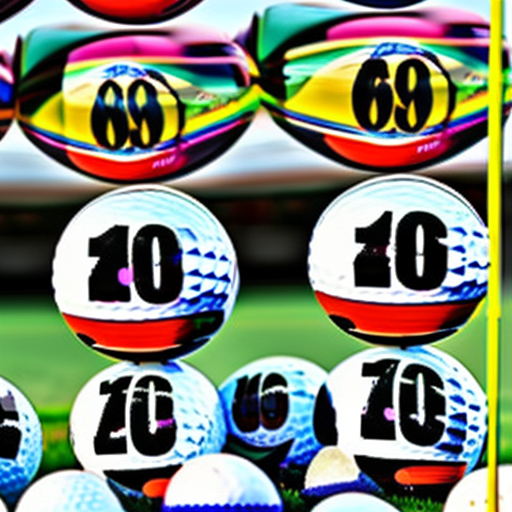Golf ball numbers can often confuse new golfers, but they serve a specific purpose. The numbers on golf balls typically indicate the compression rating, which affects how the ball performs. Understanding these numbers can help you choose the golf ball for your game. Let’s dive into what the numbers on golf balls mean and how they can impact your game.
Understanding Golf Ball Numbers

Have you ever wondered what those numbers on golf balls mean? If you’re a golf enthusiast, you’ve seen combinations like 1, 2, 3, or even four on your golf balls. These numbers hold crucial information about the specific characteristics of the ball, and understanding them can help enhance your game. In this article, we will explore the meaning behind golf ball numbers, revealing the secrets behind their designations and how they can impact your performance on the golf course.
The Meaning of the Numbers

Step 1: Understanding golf ball markings: The numbers on golf balls typically range from 1 to 4, and they indicate the ball’s compression rating. Lower numbers indicate lower compression, which means the ball will feel softer and is better suited for slower swing speeds. Higher numbers indicate higher compression, which means the ball will feel firmer and is better suited for faster swing speeds.
Step 2: Decoding the numbers: Golf ball manufacturers use the numbers to help golfers choose the right ball for their game. If you have a slower swing speed, you can utilize a lower-numbered ball for better feel and distance. If you have a faster swing speed, a higher-numbered ball may provide better control and distance.
Step 3: Understanding the significance: Knowing the meaning of the numbers on golf balls can help you choose the right ball for your game. When selecting a golf ball, it’s essential to consider your swing speed and playing style to optimize your performance on the course.
Different Types of Golf Ball Numbers

Step 1: Compression: The number on a golf ball typically represents its compression rating, which measures the ball’s hardness. Lower numbers indicate lower compression, which means the ball will compress more when struck, resulting in more distance for slower swing speeds. Higher numbers indicate higher compression and are better for faster swing speeds.
Step 2: Dimples: A number can also represent the number of dimples on a golf ball. Dimples help reduce drag and improve aerodynamics, allowing the ball to travel farther. Different numbers of dimples can affect the ball’s flight and spin.
Step 3: Branding: Some golf balls may have numbers on them to differentiate between different models or brands. These numbers have no impact on the ball’s performance but are used for identification purposes.
Impact of Golf Ball Numbers on Performance

1. Step 1: Understand the numbers: The numbers on a golf ball typically refer to the compression rating and the dimple pattern. The compression rating indicates how hard or soft the ball is, with lower numbers being softer and higher numbers being harder. The dimple pattern affects the ball’s aerodynamics and flight characteristics. Step 2: Compression rating: A lower compression rating (e.g.
2. This means the ball is softer and will compress more upon impact, making generating distance for players with slower swing speeds easier. Higher compression balls (e.g.
3. are better for players with faster swing speeds as they provide more control and accuracy. Step 3: Dimple pattern: The dimple pattern on a golf ball affects its aerodynamics and flight stability. Different dimple patterns can provide varying spin, trajectory, and distance levels. Golfers should choose a dimple pattern that best suits their playing style and desired performance.
Choosing the Right Golf Ball for Your Game

1. Step 1: Understand the compression rating: The numbers on golf balls typically refer to the compression rating, which measures how tightly wound the ball’s core is. Lower numbers (around 2) indicate a softer ball with more compression, while higher numbers (around 3) indicate a firmer ball with less compression.
Step 2: Consider the dimple pattern: The numbers on golf balls can also refer to the dimple pattern, which affects the ball’s aerodynamics. More dimples generally mean less drag and a higher ball flight, while fewer dimples mean more spin and control.
Step 3: Look at the cover material: The numbers on golf balls might also indicate the type of cover material used, such as urethane or ionomer. Urethane covers provide more spin and control, while ionomer covers offer more distance and durability.
Step 4: Determine your playing style: Consider your swing speed, spin rate, and playing conditions to choose the right golf ball for your game. A softer ball with lower compression is generally better for slower swing speeds, while a firmer ball with higher compression is better for faster swing speeds.
FAQs
1. What do the numbers on golf balls mean?
The numbers on golf balls typically represent the compression rating of the ball. Lower numbers indicate a softer compression, which can provide more distance for slower swing speeds. In comparison, higher numbers indicate a firmer compression, providing more control for faster swing speeds.
2. Do the numbers on golf balls affect performance?
Yes, the compression rating indicated by the numbers on golf balls can impact the ball’s performance, particularly in terms of distance and feel. Choosing a compression rating that fits your swing speed and playing style is essential.
3. Are there other factors to consider when choosing a golf ball?
In addition to the compression rating indicated by the numbers, golfers should also consider the dimple pattern, cover material, and overall construction of the golf ball to find the best fit for their game.
4. Can I use any golf ball regardless of the numbers on it?
While you can technically use any golf ball regardless of its numbers, choosing a ball with a compression rating that matches your swing speed and playing style can help optimize your performance.
Conclusion
The numbers on golf balls typically indicate their compression rating. A lower number, such as 70 or 80, indicates a softer ball with more compression, while a higher number, such as 90 or 100, indicates a firmer ball with less compression. The compression rating can affect the ball’s distance, spin, and feel, so choosing a golf ball with a compression rating that matches your playing style and skill level is essential.









